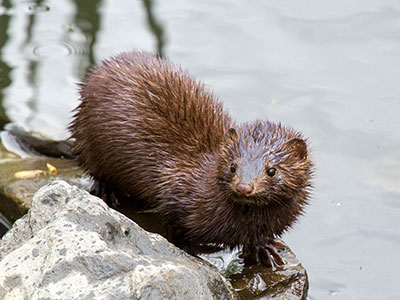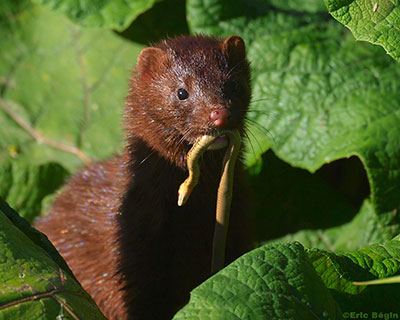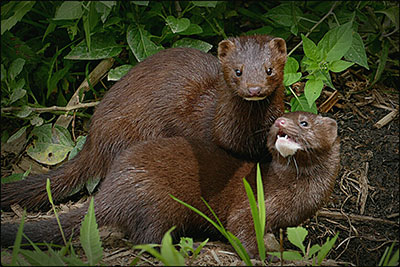Mink
(Neovison vison)
Description & Range:
Minks are approximately the size of a small housecat. They are covered with thick, dark brown fur and have a distinct white patch under their chin. Like other members of the weasel family, mink have a long, slender body and short legs. Males can weigh up to 3 pounds while females only get up to about 2 pounds. From head to tail, male minks can get up to 28 inches in length while females can be up to 25 inches.
Mink are common throughout Maryland except on the Eastern shore. They also can be found throughout much of the United States and Canada.

Mink by Chuck Homler, Wikimedia CC BY-SA 3.0
Habitat:
Mink live along lake shores, along wetland edges and along river banks, especially in areas with dense brush or those with a lot of trees. Mink require a permanent water source within their habitat. Mink will occasionally use dens throughout their travels, including those built by muskrats.
Diet:
Mink eat muskrats, mice, rabbits, small rodents, waterfowl, marsh nesting birds, crayfish, aquatic beetles and fish. Mink can hunt both on land and in water and will climb trees to find prey or will dive underwater to capture food. The mink’s diet can change with the seasons and with availability of prey. In the summer, much of its diet consists of small mammals, frogs, rodents, fish, and waterfowl. However, in the winter, the mink relies more on other mammals.

Mink and garter snake by Eric Begin, Flickr CC BY-NC-ND 2.0
Reproduction:
Mink breed in late February to April. Mink, like other weasels, will experience delayed implantation in which the fertilized egg will not implant for up to a month after breeding. After the implantation, gestation takes up to 75 days. Two to ten young, known as kits, are typically born in April. Males don't participate in raising young. The young are weaned at 6 weeks, but stay around the birth den until fall, when they disperse to find their own territory.

Pair of mink by Ken Mattison, Flickr CC BY-NC-ND 2.0
Behavior:
Minks are solitary animals. Typically, the males defend a territory of 1.2 to 3 miles on a river. This territory comprises the territories of several females. Minks are most active at night and do not hibernate. Mink may hiss, snarl, screech and/or excrete a stinky fluid from their scent glands if they feel threatened.
Management:
Annual hunting and trapping seasons for mink have been established in Maryland. Mink are managed as fur-bearing animals. To learn more about furbearer management, please click here.
Did you Know?
Despite having excellent vision and hearing, mink have a poor sense of smell. The soft fur of minks has an oily coating which makes it waterproof. Mink also molt twice a year- once in April and another time in August or September.